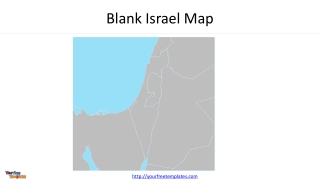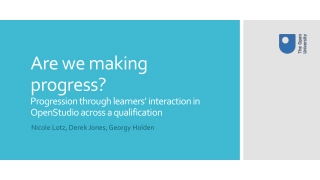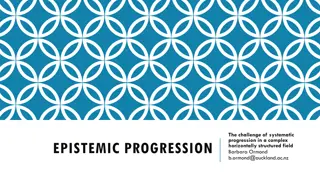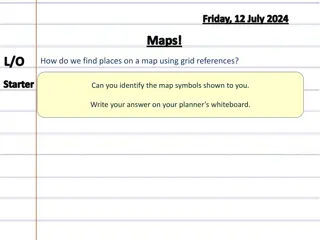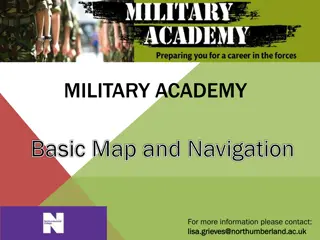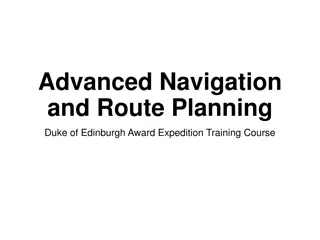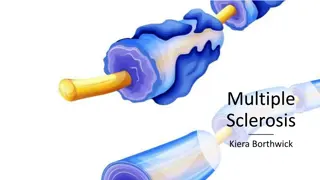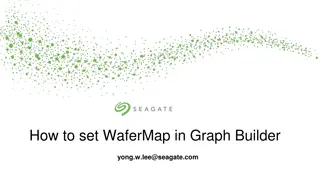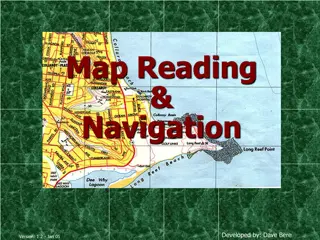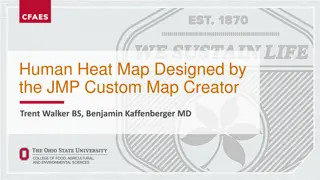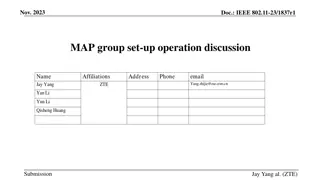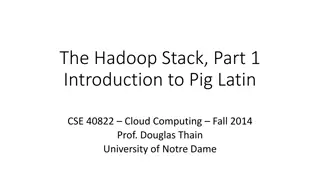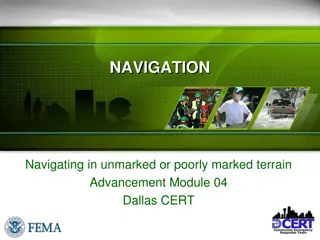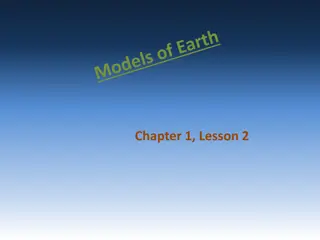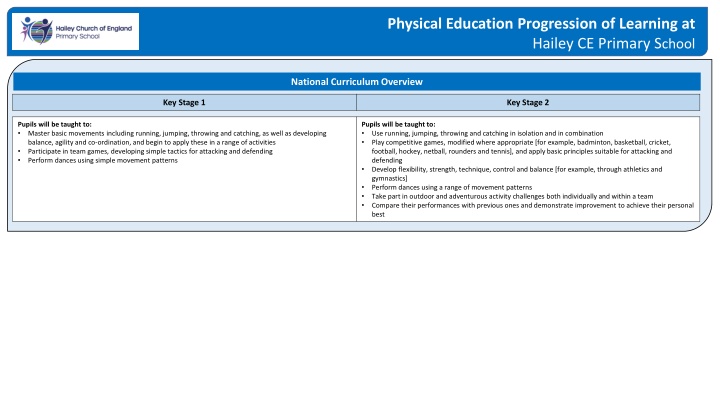
Physical Education Progression of Learning at Hailey CE Primary School
Explore the National Curriculum overview for Physical Education progression of learning at Hailey CE Primary School, covering key stages 1 and 2. Discover how students master basic movements, participate in team games, develop flexibility and strength, and engage in various physical activities to achieve their personal best.
Download Presentation

Please find below an Image/Link to download the presentation.
The content on the website is provided AS IS for your information and personal use only. It may not be sold, licensed, or shared on other websites without obtaining consent from the author. If you encounter any issues during the download, it is possible that the publisher has removed the file from their server.
You are allowed to download the files provided on this website for personal or commercial use, subject to the condition that they are used lawfully. All files are the property of their respective owners.
The content on the website is provided AS IS for your information and personal use only. It may not be sold, licensed, or shared on other websites without obtaining consent from the author.
E N D
Presentation Transcript
Physical Education Progression of Learning at Hailey CE Primary School National Curriculum Overview Key Stage 1 Key Stage 2 Pupils will be taught to: Master basic movements including running, jumping, throwing and catching, as well as developing balance, agility and co-ordination, and begin to apply these in a range of activities Participate in team games, developing simple tactics for attacking and defending Perform dances using simple movement patterns Pupils will be taught to: Use running, jumping, throwing and catching in isolation and in combination Play competitive games, modified where appropriate [for example, badminton, basketball, cricket, football, hockey, netball, rounders and tennis], and apply basic principles suitable for attacking and defending Develop flexibility, strength, technique, control and balance [for example, through athletics and gymnastics] Perform dances using a range of movement patterns Take part in outdoor and adventurous activity challenges both individually and within a team Compare their performances with previous ones and demonstrate improvement to achieve their personal best
Games Invasion (Multiskills, Invictus, Football, Hockey, Tag Rugby) Pegasus Unicorn Phoenix Griffin 3 and 4 Year Olds We will: Continue to develop our movement, balancing, riding (scooters, trikes and bikes) and ball skills We will: Show a good awareness of others in running, chasing and avoiding games, making simple decisions about when and where to run Watch and describe performances accurately Recognise what is successful Choose and use tactics to suit different situations React to situations in a way that helps our partners and makes it difficult for our opponents Understand the describe changes to our heart rate when playing different games We will: Use a range of techniques when passing, eg high, low, bounced, fast, slow Change direction and speed when dribbling the ball Adapt rules in agreement with others and, later, make rules for our own games, which we will explain and teach to others Use a range of tactics to keep possession of the ball and get into positions to shoot Show growing consistency and control in games Play with greater speed and flow Keep and use rules we are given Suggest how rules could be changed to improve the game Use the knowledge we are learning in PE to make up suitable warm-up activities for the games we are playing We will: Perform skills with accuracy, confidence and control Know the difference between attacking skills and defending skills Respond consistently in the games we play, choosing and using skills which meet the needs of the situation Use a variety of tactics to keep the ball, eg changing speed and direction Know and find ways to get the ball towards their opponents goal Choose positions in our teams and know how to help when attacking Find and use space to help our team. Know how to mark and defend our goal(s) Suggest ideas for warming up, explaining our choice Recognise exercises and activities that help strength, speed and stamina Reception Revise and refine the fundamental movement skills we have already acquired: rolling, crawling, walking, jumping, running, hopping, skipping, climbing Develop the overall body strength, co- ordination, balance and agility needed to engage successfully with future physical education sessions and other physical disciplines including dance, gymnastics, sport and swimming Develop overall body-strength, balance, co- ordination and agility Further develop and refine a range of ball skills including: throwing, catching, kicking, passing, batting, and aiming Develop confidence, competence, precision and accuracy when engaging in activities that involve a ball ELG Negotiate space and obstacles safely, with consideration for ourselves and others Move energetically, such as running, jumping, dancing, hopping, skipping and climbing
Gymnastics and Parkour Pegasus Unicorn Phoenix Griffin 3 and 4 Year Olds We will: Skip, hop, stand on one leg and hold a pose for a game like musical statues We will: Perform a range of actions with control and co- ordination Repeat accurately sequences of gymnastic actions. Move smoothly from a position of stillness to a travelling movement Move smoothly and in a controlled way from one position of stillness to another Devise, repeat and perform a short sequence in which there is a clear beginning, middle and end. Adapt the sequence to include apparatus or a partner Use different combinations of floor, mats and apparatus, showing control, accuracy and fluency We will: Perform a range of actions and agilities with consistency, fluency and clarity of movement. Make similar or contrasting shapes on the floor and apparatus, working with a partner Combine actions and maintain the quality of performance when performing at the same time as a partner Combine actions to make sequences with changes of speed, level and direction, and clarity of shape Gradually increase the length of sequences Work with a partner to make up a short sequence using the floor, mats and apparatus, showing consistency, fluency and clarity of movement Understand that strength and suppleness are key features of gymnastic performance Devise routines of stretching exercises that prepare us for our gymnastic work We will: Perform combinations of actions and agilities that show clear differences between levels, speeds and directions Perform actions, shapes and balances clearly, consistently and fluently, with good body tension and extension Repeat accurately a longer sequence with more difficult actions, with an emphasis on extension, clear body shape and changes in direction. Adapt sequences to include a partner or a small group Take more responsibility for our own warm up Know how muscles work, how to stretch, and how to carry out strengthening exercises safety Know why strength and suppleness are important in gymnastics. Reception Revise and refine the fundamental movement skills our have already acquired: rolling, crawling, walking, jumping, running, hopping, skipping, climbing Develop the overall body strength, co- ordination, balance and agility needed to engage successfully with future physical education sessions and other physical disciplines including dance, gymnastics, sport and swimming Develop overall body-strength, balance, co- ordination and agility ELG Negotiate space and obstacles safely, with consideration for ourselves and others Move energetically, such as running, jumping, dancing, hopping, skipping and climbing
Dance Pegasus Unicorn Phoenix Griffin 3 and 4 Year Olds We will: Skip, hop, stand on one leg and hold a pose for a game like musical statues Increasingly be able to use and remember sequences and patterns of movements which are related to music and rhythm We will: Talk about different stimuli as the starting point for creating dance phrases and short dances Explore actions in response to stimuli Explore ideas, moods and feelings by improvising, and by experimenting with actions, dynamics, directions, levels and a growing range of possible movements Choose and link actions to make short dance phrases that express an idea, mood or feeling, and reflect rhythmic qualities Remember and repeat a short dance phrase, showing greater control, co-ordination and spatial awareness Show some sensitivity to the accompaniment We will: Think about character and narrative ideas created by the stimulus, and respond through movement Experiment with a wide range of actions, varying and combining spatial patterns, speed, tension and continuity when working on their own, with a partner and in a group Use different compositional ideas to create motifs incorporating unison, canon, action and reaction, question and answer Remember, practise and combine longer, more complex dance phrases Communicate what we want through our dances and perform with fluency and control Show understanding of warming up and cooling down, and choose appropriate activities to do on our own We will: Explore, improvise and choose appropriate material to create new motifs in a chosen dance style Perform specific skills and movement patterns for different dance styles with accuracy Compose, develop and adapt motifs to make dance phrases and use these in longer dances Warm up and cool down independently Use exercises that stretch and tone our bodies and help us prepare for our dance Reception Revise and refine the fundamental movement skills we have already acquired: rolling, crawling, walking, jumping, running, hopping, skipping, climbing Progress towards a more fluent style of moving, with developing control and grace Develop the overall body strength, co- ordination, balance and agility needed to engage successfully with future physical education sessions and other physical disciplines including dance, gymnastics, sport and swimming Combine different movements with ease and fluency Develop overall body-strength, balance, co- ordination and agility ELG Negotiate space and obstacles safely, with consideration for ourselves and others Move energetically, such as running, jumping, dancing, hopping, skipping and climbing
Striking and Fielding (Rounders and Cricket) Pegasus Unicorn Phoenix Griffin 3 and 4 Year Olds We will: Continue to develop our movement, balancing, riding (scooters, trikes and bikes) and ball skills We will: Use a range of skills with increasing control Strike a ball with intent and throw it more accurately when bowling and/or fielding Choose and use batting or throwing skills to make the game hard for our opponents Choose where to stand as a fielder to make it hard for the batter Discuss in teams how to improve utilising others strengths We will: Intercept and stop the ball with consistency, and sometimes catch the ball Return the ball quickly and accurately Work well as a team to make it hard for the batter. Are familiar with and use the rules set and keep games going without disputes. Know the importance of warming up We will: Use different ways of bowling Bowl underarm accurately Vary how we bowl Hit the ball from both sides of the body Direct the ball away from fielders, using different angles and speeds Make up our own warm up and explain how it is organised Recognise our own and others strengths Reception Develop the overall body strength, co- ordination, balance and agility needed to engage successfully with future physical education sessions and other physical disciplines including dance, gymnastics, sport and swimming Further develop and refine a range of ball skills including: throwing, catching, kicking, passing, batting, and aiming Develop confidence, competence, precision and accuracy when engaging in activities that involve a ball ELG Move energetically, such as running, jumping, dancing, hopping, skipping and climbing
Athletics Pegasus Unicorn Phoenix Griffin 3 and 4 Year Olds: We will: Run at fast, medium and slow speeds, changing speed and direction Make up and repeat short sequences of linked jumps Take part in relay and throwing activities Use different techniques, speeds and effort to meet challenges set for running, jumping and throwing Describe what happens to our heart and breathing temperature during different types of athletic activity Identify and describe different running, jumping and throwing actions We will: Run consistently and smoothly at different speeds Demonstrate different combinations of jumps, showing control, co-ordination and consistency Throw a range of implements into a target area with consistency and accuracy Recognise that there are different styles of running, jumping and throwing, and that we need to choose the best for a particular challenge and type of equipment Pace our effort well in different types of event so that we can keep going steadily Identify and record when our body is cool, warm and hot Recognise and record that our body works differently in different types of challenge and event We will: Sustain our pace over longer distances Throw with greater control, accuracy and efficiency Organise ourselves in small groups safely, and take turns and different roles Perform a range of warm-up activities Explain how warming up can affect our performance Watch a partner s athletic performance and identify the main strengths Reception We will: Revise and refine the fundamental movement skills we have already acquired: rolling, crawling, walking, jumping, running, hopping, skipping, climbing Develop overall body-strength, balance, co- ordination and agility ELG Move energetically, such as running, jumping, dancing, hopping, skipping and climbing
Net and Wall Games (Badminton, Basketball, Netball, Table Tennis) Pegasus Unicorn Phoenix Griffin 3 and 4 Year Olds We will: Continue to develop our movement, balancing, riding (scooters, trikes and bikes) and ball skills We will: Play games using a racket, getting our body into good positions, hitting a ball fed to us accurately, and increasingly keeping a rally going using a small range of shots Try to make things difficult for our opponent by directing the ball to space, at different speeds and heights Use the rules and avoid disputes Recognise what happens to our bodies when playing the games Know why warming up is important We will: Play games using a racket, getting our body into good positions, hitting a ball fed to us accurately, and increasingly keeping a rally going using a small range of shots Try to make things difficult for our opponent by directing the ball to space, at different speeds and heights Use the rules and avoid disputes Recognise what happens to our bodies when playing the games Know why warming up is important We will: Play shots on both sides of the body and above our heads in practices and when the opportunity arises in a game Hit the ball with purpose, varying the speed, height and direction Explain what we are trying to do and why it is a good idea Carry out warm-up activities carefully and thoroughly Give good explanations of how warm-up activities affect the body Know what we are successful at and what we need to practise more Try things out and ask for help to perform better Reception Develop the overall body strength, co- ordination, balance and agility needed to engage successfully with future physical education sessions and other physical disciplines including dance, gymnastics, sport and swimming Develop overall body-strength, balance, co- ordination and agility Further develop and refine a range of ball skills including: throwing, catching, kicking, passing, batting, and aiming Develop confidence, competence, precision and accuracy when engaging in activities that involve a ball ELG Move energetically, such as running, jumping, dancing, hopping, skipping and climbing

